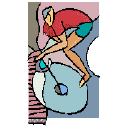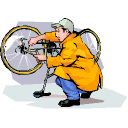 On The Road
On The Road
by: Bill Oetinger 10/1/2002
The care and feeding of your bike
 Ask my regular biking buddies, and I’m pretty certain they’ll tell you I’m not the greatest bike mechanic in the world, nor anything close to it. They’ve seen me grappling with too many little mechanicals in the middle of rides to come to any other conclusion.
Ask my regular biking buddies, and I’m pretty certain they’ll tell you I’m not the greatest bike mechanic in the world, nor anything close to it. They’ve seen me grappling with too many little mechanicals in the middle of rides to come to any other conclusion.
When they find out I’m writing a column in praise of bike maintenance, they’ll probably all fall off their chairs, convulsed in gales of mirth. Well, that’s what friends are for, I suppose: to keep us honest; to cheerfully remind us that we’re human and fallible, and therefore not to take ourselves too seriously. So okay, I admit it: I could do a better job of keeping my faithful old velocipede in tiptop trim; I could clean and lube that chain more often, or better yet, swap it for a new one before I wear out half my cogs; I could adjust the derailleur when it starts to get out of alignment, instead of living with it for weeks on end; and so on....
Life sometimes has a way of sweeping me along, so that I forget about those routine little chores that will keep the bike happy. I notice something not quite right on a ride. I promise myself I will deal with it when I get home. I get home, park the bike, take a shower, look for something to eat....and by then I’ve forgotten all about the little problem. The bike leans in the corner, silently waiting for the next ride, whereupon the problem rears its ugly little head again. Dang! I meant to fix that!
However, having said that, I will assert that although I may not be the best wrench around, I am a long way from the worst one either. And what’s more, I actually enjoy working on my bike, when I remember to do so. I have enough knowledge--and enough tools--to pretty well take my bike apart, all the way down to the frame, and then put it back together with some reasonable expectation that it will work again when I’m done. Not that I do this very often, but I do pull most of the drivetrain off from time to time, especially in the rainy months, when grit collects in all the moving parts and grinds away at them until the chain sounds like a little cement mixer.
As we are now approaching those rainy months, it seems like an opportune time to reflect on the process of bike maintenance. This will not be a how-to instructional on the subject. I’m a long way from being expert enough to give anyone advice on how to take care of their bicycle. No, all I want to do is consider how pleasant it can be to spend an afternoon doing nothing but fiddling around with one’s bike.
I once had a neighbor by the name of Philo Farnsworth III. If that name seems familiar to any of you, it might be because his father was the man who is now generally acknowledged to have invented the television. Philo the younger was also an inventor. He had a razor keen mind that quickly wrapped itself around mechanical challenges and sorted them out. One day he wandered over while I was working on (fighting with) some broken bits on a rather tired old British sports car. As anyone who has worked on old British cars can attest, frustration and emotional meltdown are never far away when up to one’s elbows in one of those gratuitously complicated buckets of bolts.
After watching me struggling for awhile, Philo offered a few words of encouragement that I have always remembered: “The thing I like about machines is that they’re simple analog technology. They’re essentially logical. If part A has an impact on part B, and part B has an impact on part C, then part A also has an indirect impact on part C, and so on.” His point being that, with most relatively simple machines, if you just sit back and study it awhile, the basic logic of how the thing works will become apparent, and so will the path you need to follow to take it apart, fix it, and put it back together again.
This may no longer be true with cars, what with all the little black boxes under the hood, but it remains very much the case with the bicycle...still nearly as simple as when the first fixed-gear scorchers came on the scene 150 years ago. A witty person once said, “The bicycle is the last thing man invented that he really understood.” (I’ve tried to find out who said that--via Google--but have so far not found the answer.) I wish I had said it, because it’s both a trenchant commentary on the bewildering morass of our modern world and a salute to one of the few remaining strongholds of simple, manageable logic in that messy world: the bike.
What all this has to do with bike maintenance should be as obvious as the bolts on a chainring. Put your bike up on the rack and look at it: all the parts are right there in front of you. There aren’t very many of them, and they’re all easy to see, easy to reach, and easy to adjust. You may need a few specialized tools, like crank pullers or freewheel removers, but even those are simple to understand and use. Almost anyone with a modicum of mechanical aptitude and interest can fiddle with a bike. And if you fiddle around enough, one of two things will happen: you will either decide you don’t enjoy fiddling with your bike (in which case you will take it to your local shop for maintenance), or you will get better at the fiddling, until you learn enough to be good at it.
 If you fall into the latter category, you will soon discover the charms of an afternoon spent taking your bike apart and putting it back together...lubed, tightened, trued, and bright-shiny clean. If you can’t be out riding--because it’s raining--a good alternative is to get cozy with your bike in your garage or workshop. Turn on the radio if you want some company, or just let the patter of raindrops on the roof be your sound track. Make sure you have an armload of clean rags. Old century t-shirts with too much pasta sauce on the front are useful for this, although my work rags of choice come from old flannel sheets.
If you fall into the latter category, you will soon discover the charms of an afternoon spent taking your bike apart and putting it back together...lubed, tightened, trued, and bright-shiny clean. If you can’t be out riding--because it’s raining--a good alternative is to get cozy with your bike in your garage or workshop. Turn on the radio if you want some company, or just let the patter of raindrops on the roof be your sound track. Make sure you have an armload of clean rags. Old century t-shirts with too much pasta sauce on the front are useful for this, although my work rags of choice come from old flannel sheets.
I usually clean and lube (or replace) my chain first, as it’s a messy business. Sometimes I take it off the bike and hang it on a nail in the shop doorway, where I can get at it better. Other times I just give it a once over on the bike. I have tried every method known to man for lubing my chains, from the sacred ritual of the stove top wax job to spray and drip lubes of all sorts. None of them is completely satisfactory, in my opinion. The chains always get funky, and usually sooner than later. Nevertheless, you can’t give way to despair in this department. It has to be done, early and often. I, who so often backslide in this respect, have learned this the hard way.
While the chain is off, I may take off my chainrings and maybe my jockey pulley wheels. Maybe also the cogs, if I’m feeling ambitious. Unless they’re worn out, this is just for cleaning. Clean gears run smooth and look pretty. And while all those spikey gears are off, I can get at the little nooks and crannies behind them and root out the icky goo that accumulates in the hard-to-reach spots.
Then I pay some attention to my wheels. I take them to my work bench, clean them carefully, checking spoke tension, looking for cracks in the rims, and making sure the hubs are happy. I also give my tires a flinty-eyed inspection, looking for cuts or wear. I like to know--when descending at 50-mph--that my tires and wheels are in good shape. Some people love to build their own wheels and get positively mystical about the whole experience. Not me. I prefer to have my wheels built by experts who have built hundreds of them. While I know I could do my own, I’m convinced wheels built by experienced pros stay true and trouble-free longer. I run some fairly straightforward, bomb-proof rims, and aside from wheels damaged in crashes, I have only broken one spoke in over 30 years of hard riding--I’m knocking on wood as I write this--and I hardly ever even have to pick up a spoke wrench to retrue a wheel. In fact, I have run some wheels for several years without ever having to touch a single spoke.
With the wheels and drivetrain off the bike, I give the frame a thorough inspection, looking for any little signs of wear. I ride an old Merlin, and the welds are the most beautifully pristine and perfect I have ever seen on a bike. I don’t really think the frame is going to crack, but I have friends who ride Merlins who have had that happen to them, so I know it’s not impossible. I’m not going to tempt fate by ignoring this simple inspection.
Besides, I just love admiring that frame. I’m not hard-core retro when it comes to bike design, but I do think the simple lines of my frame represent just about the perfect distillation of the framemaker’s art. The fact that the bike has no paint and no decals at all only adds to the elegant simplicity of its geometry and construction.
Forgive me for getting carried away with my enthusiasm for my bike! But in a way, that illustrates my point about how pleasant it can be to spend an afternoon fiddling about with one’s bike. I find the whole experience satisfying in an almost sensual way....becoming deeply absorbed in all the little components; how they interact with one another; what makes them work best; what keeps them from rattling or binding or breaking. A good bike is a beautifully crafted tool, and observing how it does what it does is very rewarding, in and of itself....aside from the fact that you are--at least in theory--helping it to work better, and ultimately helping it to help you work better, when you ride it.
Where was I? The list of things that need to be looked at and possibly serviced goes on and on: pedals, bar tape, head set, brakes, cables, derailleurs.... Some need regular attention. Others just go on doing what they do, year after year. I haven’t had to touch my Chris King headset since I put it in, many years ago. A turn of a screw here: problem solved! A squirt of lube there: order restored!
Finally, when everything is ship shape, and all the bits have been bolted and clamped and screwed back together. I indulge in my favorite ritual: the steel wool. Now this will draw a blank from almost all of you, I’m sure. But if you own a titanium bike (with no decals), you will know what I mean. Buffing out the unpainted ti tubes with fine steel wool will make them glow with a satiny, shimmering light, almost as if they were illuminated from within. And the more you do it over the years, the prettier the finish becomes. Up and down the tubes I go, buffing and polishing, like a fussy contestant in a Concours d’Elegance. When I finally have every smudge and scratch buffed out, and the bike looks better than showroom new, I set it up against the wall, pull up a chair, and just sit and admire it....my good friend, my bike.
When I think of all the miles we have covered together; all the joy and suffering, the hilarity and carefree, dancing, delight; the places we have been; the scenery we have seen. Is it any wonder I feel a bond of friendship and sympathy with this honest, simple machine? Taking care of it; tending to its little wounds and ailments; seeing it has what it needs to thrive and prosper.... It seems that’s the least I can do to repay it for all its years of service.
Next time it rains on your weekend ride plans, think of your own good friend over there in the corner....your Columbine, Colnago, or Calfee....and consider the satisfaction that comes from getting your hands dirty while you get your bike clean.
Bill can be reached at srccride@sonic.net


